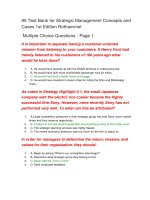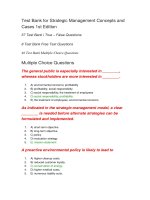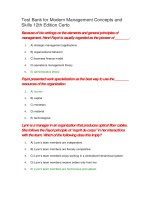Test bank strategic management concepts and cases 12th ch1
Bạn đang xem bản rút gọn của tài liệu. Xem và tải ngay bản đầy đủ của tài liệu tại đây (188.76 KB, 71 trang )
Name
:
Clas
s:
Dat
e:
Chapter 01: Strategic Management and Strategic Competitiveness
True / False
1. Strategic competitiveness is achieved when a firm successfully formulates and implements a value-creating strategy.
a. True
b. Fals
e
ANSWER: True
2. Alligator Enterprises has earned above-average returns since its founding five years ago. No other firm has challenged
Alligator in its particular market niche; therefore, the firm's owners can feel secure that Alligator has established a
competitive advantage.
a. True
b. Fals
e
ANSWER: Fals
e
Copyright Cengage Learning. Powered by Cognero.
Page 1
Name
:
Clas
s:
Dat
e:
Chapter 01: Strategic Management and Strategic Competitiveness
3. The goal of strategy implementation is to develop a permanent competitive advantage.
a. True
b. Fals
e
ANSWER: Fals
e
4. Risk in terms of financial returns reflects an investor's uncertainty about economic gains or losses that will result from a
particular investment.
a. True
b. Fals
e
ANSWER: True
5. Average returns are those in excess of what an investor expects to earn from other investments with a similar amount of
risk.
a. True
Copyright Cengage Learning. Powered by Cognero.
Page 2
Name
:
Clas
s:
Dat
e:
Chapter 01: Strategic Management and Strategic Competitiveness
b. Fals
e
ANSWER: Fals
e
6. Above average returns are those in excess of what an investor expects to earn from other investments with similar stock
prices.
a. True
b. Fals
e
ANSWER: True
7. Returns can only be measured in accounting terms such as return on assets, return on equity, or return on sales.
a. True
b. Fals
e
ANSWER: Fals
Copyright Cengage Learning. Powered by Cognero.
Page 3
Name
:
Clas
s:
Dat
e:
Chapter 01: Strategic Management and Strategic Competitiveness
e
8. To implement a firm’s strategies, the firm takes actions to with the goal of achieving strategic competitiveness and
above average returns.
a. True
b. Fals
e
ANSWER: True
9. Economies of scale and huge advertising budgets are just as effective in the new competitive landscape as they were in
the past.
a. True
b. Fals
e
ANSWER: Fals
e
Copyright Cengage Learning. Powered by Cognero.
Page 4
Name
:
Clas
s:
Dat
e:
Chapter 01: Strategic Management and Strategic Competitiveness
10. The two primary drivers of hypercompetition are the emergence of the global economy and technology.
a. True
b. Fals
e
ANSWER: True
11. The rate of technology diffusion has been steadily increasing over the last two decades.
a. True
b. Fals
e
ANSWER: True
12. While patents may be an effective way of protecting proprietary technology, many firms competing in the electronics
industry do not apply for patents to prevent competitors from utilizing the technological knowledge that would be
included in the patent application.
a. True
Copyright Cengage Learning. Powered by Cognero.
Page 5
Name
:
Clas
s:
Dat
e:
Chapter 01: Strategic Management and Strategic Competitiveness
b. Fals
e
ANSWER: True
13. Examples of incremental innovations include iPods, PDAs, Wi-Fi, and web browser software.
a. True
b. Fals
e
ANSWER: Fals
e
14. The rapid rate of technological diffusion has increased the competitive benefits of patents.
a. True
b. Fals
e
ANSWER: Fals
Copyright Cengage Learning. Powered by Cognero.
Page 6
Name
:
Clas
s:
Dat
e:
Chapter 01: Strategic Management and Strategic Competitiveness
e
15. Developed countries still have major advantages in their access to information technology when compared to
emerging economies because of the significant cost of the infrastructure needed for computing power.
a. True
b. Fals
e
ANSWER: Fals
e
16. The rate of growth of Internet-based applications could be affected by strategies of Internet service providers charging
users for downloading those applications.
a. True
b. Fals
e
ANSWER: True
Copyright Cengage Learning. Powered by Cognero.
Page 7
Name
:
Clas
s:
Dat
e:
Chapter 01: Strategic Management and Strategic Competitiveness
17. The new CEO of Opacity Enterprises is determined to make the long-established firm strategically flexible. The CEO
feels that the employees of the company have the ability, training, and resources to engage in continuous learning. The
CEO must encourage ambidextrous learning, absorbing new knowledge and building incremental knowledge.
a. True
b. Fals
e
ANSWER: True
18. The I/O (industrial organization) model assumes that the uniqueness of a firm's resources and capabilities is the main
source of above-average returns.
a. True
b. Fals
e
ANSWER: Fals
e
19. The CEO of Twin Spires, Inc., is committed to using the expertise and resources currently in the firm to serve the
needs of the natural gardening community by providing rare and native plants to individuals and nurseries around the
United States. The perspective of the CEO of Twin Spires is consistent with the assumptions of the industrial organization
Copyright Cengage Learning. Powered by Cognero.
Page 8
Name
:
Clas
s:
Dat
e:
Chapter 01: Strategic Management and Strategic Competitiveness
(I/O) model.
a. True
b. Fals
e
ANSWER: Fals
e
20. The five forces model suggests that firms should target the industry with the highest potential for above-average
returns and then implement either a cost-leadership strategy or a differentiation strategy.
a. True
b. Fals
e
ANSWER: True
21. The uniqueness of a firm's resources and capabilities is the basis for a firm's strategy and determines its ability to earn
above-average returns under the I/O view.
a. True
Copyright Cengage Learning. Powered by Cognero.
Page 9
Name
:
Clas
s:
Dat
e:
Chapter 01: Strategic Management and Strategic Competitiveness
b. Fals
e
ANSWER: True
22. Research shows that a greater percentage of a firm's profitability is explained by the I/O rather than the resource-based
model.
a. True
b. Fals
e
ANSWER: Fals
e
23. The resource-based model assumes that firms must have resources that are rare or costly to imitate to form a basis for
competitive advantage.
a. True
b. Fals
e
ANSWER: Fals
Copyright Cengage Learning. Powered by Cognero.
Page 10
Name
:
Clas
s:
Dat
e:
Chapter 01: Strategic Management and Strategic Competitiveness
e
24. Resources are considered rare when they have no structural equivalent.
a. True
b. Fals
e
ANSWER: Fals
e
25. The assumptions of the industrial organization model and the resource-based model are contradictory. Therefore,
organizational strategists must choose one or the other model as the basis for developing a strategic plan.
a. True
b. Fals
e
ANSWER: Fals
e
Copyright Cengage Learning. Powered by Cognero.
Page 11
Name
:
Clas
s:
Dat
e:
Chapter 01: Strategic Management and Strategic Competitiveness
26. An effective vision statement must specify the industry in which a company will operate.
a. True
b. Fals
e
ANSWER: Fals
e
27. An effective vision stretches and challenges people and can result in increased innovation. This is illustrated by
Apple's CEO Steve Jobs, who was known to think bigger and differently than most people ("putting a dent in the
universe").
a. True
b. Fals
e
ANSWER: True
28. Organizational mission statements typically do not include statements about profitability and earning above-average
returns.
a. True
Copyright Cengage Learning. Powered by Cognero.
Page 12
Name
:
Clas
s:
Dat
e:
Chapter 01: Strategic Management and Strategic Competitiveness
b. Fals
e
ANSWER: True
29. A firm's mission tends to be enduring while its vision can change in light of changing environmental conditions.
a. True
b. Fals
e
ANSWER: Fals
e
30. Organizational stakeholders are the firm's internal resources, capabilities, and core competencies that are used to
accomplish what may appear to be unattainable goals in the competitive environment.
a. True
b. Fals
e
Copyright Cengage Learning. Powered by Cognero.
Page 13
Name
:
Clas
s:
Dat
e:
Chapter 01: Strategic Management and Strategic Competitiveness
ANSWER: Fals
e
31. If a firm is dependent on a specific stakeholder group, that group has less influence on the firm’s strategic decision
making.
a. True
b. Fals
e
ANSWER: Fals
e
32. Relative power is the most critical element for prioritizing the demands of stakeholders.
a. True
b. Fals
e
ANSWER: True
Copyright Cengage Learning. Powered by Cognero.
Page 14
Name
:
Clas
s:
Dat
e:
Chapter 01: Strategic Management and Strategic Competitiveness
33. Hourly workers on the production line of a chicken-processing plant are considered organizational stakeholders.
a. True
b. Fals
e
ANSWER: True
34. Customers, suppliers, unions, and local governments are examples of capital market stakeholders.
a. True
b. Fals
e
ANSWER: Fals
e
35. When a firm earns lower-than-average returns, the highest priority is given to satisfying the needs of capital market
stakeholders over the needs of product market and organizational shareholders.
a. True
Copyright Cengage Learning. Powered by Cognero.
Page 15
Name
:
Clas
s:
Dat
e:
Chapter 01: Strategic Management and Strategic Competitiveness
b. Fals
e
ANSWER: Fals
e
36. Six years ago, Colette Smith founded a successful catering company that specializes in providing a wide assortment of
miniature cheesecakes for corporate and social events. Although Ms. Smith is no longer active in the actual production of
the cheesecakes, she continues as president of the catering company. Ms. Smith could be considered a strategic leader of
this firm.
a. True
b. Fals
e
ANSWER: True
37. Although organizational cultures vary considerably, one cannot make an objective judgment that some organizational
cultures are more or less functional than others in terms of ethical considerations.
a. True
b. Fals
e
Copyright Cengage Learning. Powered by Cognero.
Page 16
Name
:
Clas
s:
Dat
e:
Chapter 01: Strategic Management and Strategic Competitiveness
ANSWER: Fals
e
38. Strategic leaders must have a strong strategic orientation while embracing change in the dynamic competitive
landscape.
a. True
b. Fals
e
ANSWER: True
39. Corporate-level strategy in a diversified organization requires a common business strategy for each component
business.
a. True
b. Fals
e
ANSWER: Fals
e
Copyright Cengage Learning. Powered by Cognero.
Page 17
Name
:
Clas
s:
Dat
e:
Chapter 01: Strategic Management and Strategic Competitiveness
40. An organization's willingness to tolerate or encourage unethical behavior is a reflection of its core values.
a. True
b. Fals
e
ANSWER: True
Multiple Choice
41. A firm has achieved ______ when it successfully formulates and implements a value-creating strategy.
a. strategic competitiveness
b. a permanently sustainable competitive advantage
c. substantial returns
d. legal and ethical core values
ANSWER: a
Copyright Cengage Learning. Powered by Cognero.
Page 18
Name
:
Clas
s:
Dat
e:
Chapter 01: Strategic Management and Strategic Competitiveness
42. A competitive advantage:
a. can be permanent if the firm has successfully implemented the strategic management
process.
b. entails reducing investors' risk to near zero.
c. can be identified when competitors are unable to duplicate or find it too costly to try to
imitate.
d. exists when competing firms are unable to find investors.
ANSWER: c
43. Above-average returns are;
a. higher profits than the firm earned the previous year.
b. higher profits than the industry averaged over the last 10 years.
c. profits in excess of what an investor expects to earn from a historical pattern of
performance of the firm.
d. returns in excess of what an investor expects to earn from other investments with a
Copyright Cengage Learning. Powered by Cognero.
Page 19
Name
:
Clas
s:
Dat
e:
Chapter 01: Strategic Management and Strategic Competitiveness
similar level of risk.
ANSWER: d
44. The strategic management process is;
a. a set of activities that will assure a sustainable competitive advantage and aboveaverage returns for the firm.
b a decision-making activity concerned with a firm's internal resources, capabilities, and
. competencies, independent of the conditions in its external environment.
c. a process directed by top-management with input from other stakeholders that seeks to
achieve above-average returns for investors through effective use of the organization's
resources.
d the formulation and implementation of a full set of commitments, decisions, and
. actions required for the firm to achieve above-average returns and strategic
competitiveness.
ANSWER: d
45. According to Hitt, the primary drivers of hypercompetition are:
a. rising global socio-economic instability and increased inflation.
Copyright Cengage Learning. Powered by Cognero.
Page 20
Name
:
Clas
s:
Dat
e:
Chapter 01: Strategic Management and Strategic Competitiveness
b. the emergence of a global economy and rapid technological change.
c. increased global competition and decreased tariffs.
d. increased availability of capital and increased competition.
ANSWER: b
46. All of the following are characteristics of the global economy EXCEPT:
a. the increasing importance of developing countries as sources of revenue growth.
b. the free movement of goods, services, people, skills, and ideas across geographic
borders.
c. the increased use of tariffs to protect industries.
d. higher levels of opportunities and challenges in new geographic markets.
ANSWER: c
Copyright Cengage Learning. Powered by Cognero.
Page 21
Name
:
Clas
s:
Dat
e:
Chapter 01: Strategic Management and Strategic Competitiveness
47. Essentially, _______ has become one of the world's largest markets with 700 million potential consumers.
a. the European Union
b. the United States
c. China
d. Japan
ANSWER: a
48. ______ has become the second-largest economy in the world.
a. The United States
b. The European Union
c. Japan
d. China
ANSWER: d
Copyright Cengage Learning. Powered by Cognero.
Page 22
Name
:
Clas
s:
Dat
e:
Chapter 01: Strategic Management and Strategic Competitiveness
49. The economic interdependence among countries which is reflected in the flow of goods, services, financial capital,
and knowledge across country borders is defined as:
a. hypercompetition.
b. boundaryless retailing.
c. strategic intensity.
d. globalization.
ANSWER: d
50. Globalization has led to:
a. lower operational efficiency as firms must transport raw materials and finished goods
farther.
b. increasing loyalty of customers for products made domestically.
c. declining returns from investment in research and development.
d. higher performance standards including quality and cost.
Copyright Cengage Learning. Powered by Cognero.
Page 23
Name
:
Clas
s:
Dat
e:
Chapter 01: Strategic Management and Strategic Competitiveness
ANSWER: d
51. The "liability of foreignness" is the:
a. inability of most U.S. managers to truly comprehend foreign cultures.
b.political disadvantage that U.S. firms have when doing business abroad.
c. overall risk of participating outside a firm's domestic country when entering global
competition.
d.preference for "buying local," which always puts foreign firms at a disadvantage when
competing in the U.S. market.
ANSWER: c
52. Even for companies capable of succeeding in global markets, it is critical that they:
a. remain committed to and strategically competitive in their domestic market.
b. introduce many new products immediately after entering a new market.
c. acquire a local competitor in each significant foreign market.
Copyright Cengage Learning. Powered by Cognero.
Page 24
Name
:
Clas
s:
Dat
e:
Chapter 01: Strategic Management and Strategic Competitiveness
d. develop good negotiating skills in order to take advantage of local suppliers in the
international market.
ANSWER: a
53. The rate of technological diffusion is increasing. Which of the following was fastest in penetrating 25 percent of
homes in the U.S. market?
a. Mobile Phone
b. Television
c. Personal Computer
d. Internet
ANSWER: d
54. New markets created by iPods, PDAs, and Wi-Fi are a result of:
a. disruptive technologies.
Copyright Cengage Learning. Powered by Cognero.
Page 25









